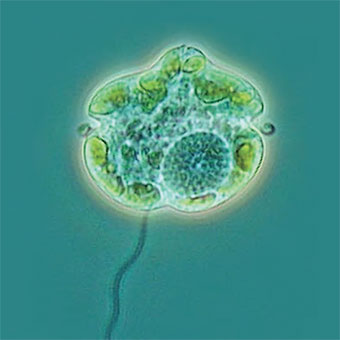Features
Red Alert

Mote Marine Laboratory’s Barbara Kirkpatrick says a significant bloom can be a trigger for asthma and other lung diseases.
Photo by Katy Hennig | USF News

Karenia brevis, the Gulf’s red tide species, is a higher than usual concentration of phytoplankton that can produce toxic effects on people, marine organisms and birds.
Photo by David Patterson | micro*scope
Barbara Kirkpatrick, a senior scientist at Mote Marine Laboratory, has been studying the public health impacts of red tides for more than 13 years. The blooms, she explains, release a toxin, or chemical irritant.
“When we inhale these toxins, it’s an irritant to our airway similar to if you take a whiff of bleach or ammonia,” she says.
“One study we’ve done looking at the local emergency room here in Sarasota showed that a bloom can impact emergency room visits at one hospital anywhere from half-a-million to $4 million in increased visitation.”
Mote’s first studies on human health associated with the toxic bloom got under way in 2000. Since then, Kirkpatrick says, Mote scientists have learned a significant bloom is a trigger for asthma, and can cause eye tearing, nasal congestion and a runny nose in the general population.
Among other things, the findings led to the creation of a beach conditions reporting system for the public. Implemented in 2006, the report covers 26 beaches along Florida’s Gulf Coast from the Panhandle south to Lee County. The system lets beach-goers know when it’s a good day for the beach and what beaches to avoid.
“Prior to our studies, the message was that Florida red tide can cause some upper-airway irritation and if you leave the beach you’ll be okay,” Kirkpatrick says. “Now the messaging, especially for people who have asthma and other lung diseases, is you really need to avoid days when there are a lot of toxins in the air.”